- Quick Read
- Deep Read ( 5 Min. )
In Today’s Issue
- Even amid Palestinian joy over freed prisoners, wariness mounts
- In New York fraud trial, Trump defense is offense
- Americans need child care help. Enter the Child Care Business Lab.
- How lab-grown diamonds are reshaping this western India city
- A chance to grow: How China and a British town are sowing seeds
Monitor Daily Podcast
- Follow us:
- Apple Podcasts
- Spotify
- RSS Feed
- Download
TODAY’S INTRO
In India, ‘rat miners’ become national heroes
 Mark Sappenfield
Mark Sappenfield
A rescue operation that was supposed to last a few days is now over. Seventeen days after a tunnel under construction collapsed in the Indian Himalayas, the 41 miners trapped inside are free.
Two different drilling machines broke before a team of miners used a technique called rat-hole mining – so dangerous it was outlawed in 2014 – to at last get through. It is as unpleasant as it sounds, navigating tight spaces with only a hand drill. But “when we saw them inside the tunnel after the breakthrough,” one rescuer said, “we hugged them like they were family.”
Share this article
Link copied.

Help fund Monitor journalism for $11/ month
Already a subscriber? Login

Monitor journalism changes lives because we open that too-small box that most people think they live in. We believe news can and should expand a sense of identity and possibility beyond narrow conventional expectations.
Our work isn't possible without your support.
Even amid Palestinian joy over freed prisoners, wariness mounts
As tensions rise in the West Bank, Palestinians there are increasingly frustrated with their government. Amid prisoner exchanges in Gaza, some West Bank Palestinians are now flying the green flag of Hamas. It’s not a sign of support so much as a pent-up demand for change.

-
By Fatima AbdulKarim Special contributor
-
Taylor Luck Special correspondent
Family reunions have been playing out across east Jerusalem and the occupied West Bank this week as Israel released Palestinian women and children prisoners in return for hostages freed by Hamas.
With each nightly prisoner release, the green flag of the Islamist Hamas has been raised in the West Bank, overtaking the yellow flag of Fatah, the faction that dominates the West Bank. The shows of appreciation for Hamas coincide with frustration with the ineffective and increasingly autocratic Palestinian Authority.
Yet there is an underlying wariness amid the arrests and violence still spiraling across the West Bank, and concerns that war is set to begin anew in Gaza.
“Our happiness feels incomplete with ongoing war and the losses we are seeing in Gaza,” Buthaina Matar said while waiting at a checkpoint for her sister Rawan to be released.
Rawan, among the first batch of Palestinian prisoners to be released, stepped off the International Committee of the Red Cross bus and hugged her family. With a wary face, she said her freedom was bittersweet. “Our happiness will only be complete when the Israeli jails are truly all empty,” she said.
Even amid Palestinian joy over freed prisoners, wariness mounts

Nihaya Abu Al-Humus hugged and kissed her 17-year-old son, Muhammed, over and over again in the family room of their east Jerusalem home as if she hadn’t seen him in a lifetime.
“This is the dream I prayed for,” said Ms. Abu Al-Humus, cradling her son Tuesday, six months after he had been arrested by Israeli police in a roundup of local youth in his neighborhood in August.
Reunions like this have been playing out across east Jerusalem and the West Bank this week as Israel released women and children prisoners in return for Israeli hostages freed by Hamas, the militant group that rules Gaza.
The releases have reunited Palestinian families, returned mothers to their children, and sent home boys and girls, mostly teenagers between the ages of 15 and 17. And they have spurred celebrations resembling rallies in front of prisons in Israel and at Israeli checkpoints in the occupied West Bank.
With each nightly Israeli release of Palestinian prisoners, Palestinians in the heart of the West Bank have raised the green flag of the Islamist Hamas, overtaking the traditional yellow flag of Fatah, the Palestinian faction that dominates the West Bank and the governing Palestinian Authority.
It is the largest and most visible expression of pro-Hamas sentiment in the West Bank since the 2007 schism in which Hamas evicted Fatah from Gaza.
The spike in shows of appreciation for Hamas coincides with frustration with Fatah and the ineffective and increasingly autocratic Palestinian Authority. Yet there is an underlying wariness among Palestinians that the detainee releases offer only a temporary relief for a few families and are no solace for the suffering and deaths of friends and relatives in Gaza.
Moreover, with arrests and violence still spiraling across the West Bank, and concerns that war is set to begin anew in Gaza, Palestinians say the fleeting joy is no substitute for a resolution to the overall conflict. The release of detainees, they say, does nothing to ease the uncertainty and violence they face on a daily basis.

“Our happiness feels incomplete with ongoing war and the losses we are seeing in Gaza,” Buthaina Matar said Friday night as she waited for hours at a prison checkpoint in Beitunia for her sister Rawan to be released.
Rawan, who was charged with causing bodily harm to an Israeli soldier and was among the first batch of Palestinian prisoners to be released, stepped off the International Committee of the Red Cross bus and hugged her family. With a wary face, she said her freedom was bittersweet.
“Our happiness will only be complete when the Israeli jails are truly all empty,” Rawan said.
In the five rounds of hostage-prisoner exchanges since Nov. 24, Hamas has released 60 Israeli hostages it abducted Oct. 7 and Israel has released 180 Palestinian women and children held in its jails. A sixth exchange was in the works Wednesday.
As of late Wednesday, the United States, Egypt, and Qatar continued urgent talks to broker an agreement between Israel and Hamas to extend the pause in fighting past its Thursday morning deadline to facilitate further releases.
The detainee releases have so far excluded Palestinians who Israel says have carried out lethal attacks and Hamas militants whom Hamas wants released – and Israeli soldiers held by Hamas.
The released Palestinian women and minors were being held on charges that, according to the Israeli government, ranged from “association” with an illegal group and “throwing stones” to “damage to security area” and “attempted murder.”
The Hamas flags in the West Bank have been a protest statement.
For released Palestinians and their families, it has been both a relief and a burden knowing that the reason for their release is a war that as of Wednesday has killed more than 13,000 Palestinians in Gaza and also claimed the lives of 1,200 Israelis Oct. 7.
“The sentiments we saw on the ground in Beitunia, in Al-Bireh, and in Ramallah mirror the will of the people, which is a public dismay over Fatah’s strategy of endless years of negotiations, yielding nothing,” says researcher and former detainee Esmat Mansour.
Less than a demonstration of an ideological affinity for Hamas, analysts say the surge in pro-Hamas expressions is born of frustration over passive Palestinian leadership amid Israeli military raids, settler attacks, and an unprecedented wave of arrests. According to the United Nations, the raids have killed 232 Palestinians, including 61 children, in the West Bank since Oct. 7.
“The people simply do not see any action from the PLO or the Palestinian Authority leadership,” says Mr. Mansour, who was released in 2011 with hundreds of others in return for captive Israeli soldier Gilad Shalit.
With 3,260 Palestinians arrested in the West Bank and east Jerusalem since Oct. 7, according to the Palestinian Prisoners’ Society, there is also a fear among families that their loved ones’ releases offer only a temporary reprieve.
“As long as there is an occupation, the arrests will not stop,” says Palestinian Prisoners’ Society spokesperson Amany Sarahnah. “People must understand this is a central policy of occupation against the Palestinians to restrict any kind of resistance.”

Underscoring those concerns: In the first four days of the Israel-Hamas truce, Israel arrested 133 Palestinians, compared with 150 who were released. Israel says the recently arrested Palestinians were militants planning attacks or had expressed support for terrorism; Palestinians say many of those arrested were detained for online posts denouncing the war in Gaza or supporting Hamas.
Some 6,704 Palestinians are held in Israeli jails, according to the Israeli nongovernmental organization HaMoked. Of those, at least 2,070 are held in administrative detention without charge – a form of detention that Palestinian and Israel human rights groups say has been on the rise since Oct. 7.
Nariman Tamimi’s husband, veteran Fatah activist Bassem Tamimi, and her daughter activist Ahed Tamimi were both arrested and placed in administrative detention in the weeks after the Oct. 7 attack.
The younger Ms. Tamimi, who was set to be released late Wednesday, was arrested at the family home in Nabi Saleh outside Ramallah for a post calling for violence against Israelis on what the family says was a fake social media account bearing her name.
“Far-right Israeli activists are putting photos of me online and calling for my arrest as well. We live every moment knowing any of us can be arrested at any moment,” Ms. Tamimi says. “I am not going to cry for my husband and daughter, because all my tears have been used up for Gaza.”
“Most of us Palestinian men go in and out of prison from when we are little. It is not a question of if, but when,” says Abu Laith in Ramallah, a delivery driver who spent two stints in Israeli prisons in the early 2000s. His son, he says, was arrested two years ago for throwing stones at Israeli soldiers and was released earlier this year.
“This war may have brought temporary relief to a few families, but it is all temporary,” he says. “We are still living in an open-air Israel prison, and at any moment any of us will be taken to a concrete prison.”

In New York fraud trial, Trump defense is offense
Among the array of lawsuits facing former President Donald Trump, he seems to find the fraud case in New York particularly galling. Here, we help sort out the details of the case and examine what it could mean to Mr. Trump.

- Quick Read
- Deep Read ( 6 Min. )
Former President Donald Trump substantially lost his civil fraud trial in New York before it even began. Prior to the start of testimony, Judge Arthur Engoron ruled that evidence showed Mr. Trump and other defendants were guilty of the core charge in the case: fraudulently overvaluing real estate assets.
But with punishment yet to be determined and likely appeals looming, the former president has nevertheless been mounting a ferocious multipronged defense. He has combined salesmanship patter with vitriolic social media attacks and testimony from sympathetic experts, arguing he is being unfairly prosecuted for a victimless crime.
The defense has continued to call witnesses this week, with Mr. Trump himself set to return to the stand on Dec. 11, according to his lawyers. And while he has faced an uphill climb in the proceedings, his lawyers have made clear that Trump entities are not conceding anything and believe the finding of fraud was premature – paving the way for a lengthy appeals process.
“Whether the defense strategy will have much impact on the judge is doubtful, but it appears that the defense is playing a long game,” says Stephen A. Saltzburg, a law professor at George Washington University Law School, in an email.
In New York fraud trial, Trump defense is offense

Former President Donald Trump substantially lost his civil fraud trial in New York before it even began. Prior to the start of testimony, Judge Arthur Engoron ruled that evidence showed Mr. Trump and other defendants were guilty of the core charge in the case: fraudulently overvaluing real estate assets.
But with punishment yet to be determined and likely appeals looming, the former president has nevertheless been mounting a ferocious multipronged defense, combining salesmanship patter with vitriolic social media attacks and testimony from sympathetic experts as he argues he is being unfairly prosecuted for a victimless crime.
The defense has continued to call witnesses this week, with Mr. Trump himself set to return to the stand on Dec. 11, according to his lawyers. It is likely to be a pugnacious appearance; the first time he testified in the case, on Nov. 6, he called prosecutors “haters” who had grossly underestimated the value of many of his buildings.
Outside the courtroom, Mr. Trump has used scathing language about the New York proceedings, attacking New York state Attorney General Letitia James, Judge Engoron, and Judge Engoron’s chief clerk in ferocious personal terms. Judge Engoron slapped a gag order on the former president to stop these insults at the trial’s beginning, but an appeal court judge suspended the order while the two sides debate whether it violates Mr. Trump’s First Amendment rights.
Why does the former president seem so exercised about the New York fraud case? As a civil matter, it does not threaten him with prison, as do the election fraud and Mar-a-Lago document cases filed by special counsel Jack Smith, and Fulton County District Attorney Fani Willis’s case charging Mr. Trump and others with conspiring to meddle in the Georgia presidential vote.
Perhaps it is because the New York case attacks Mr. Trump’s self-image. Prosecutors have depicted him not as a savvy, wealth-creating real estate magnate, but as a cheater who lies about his net worth.
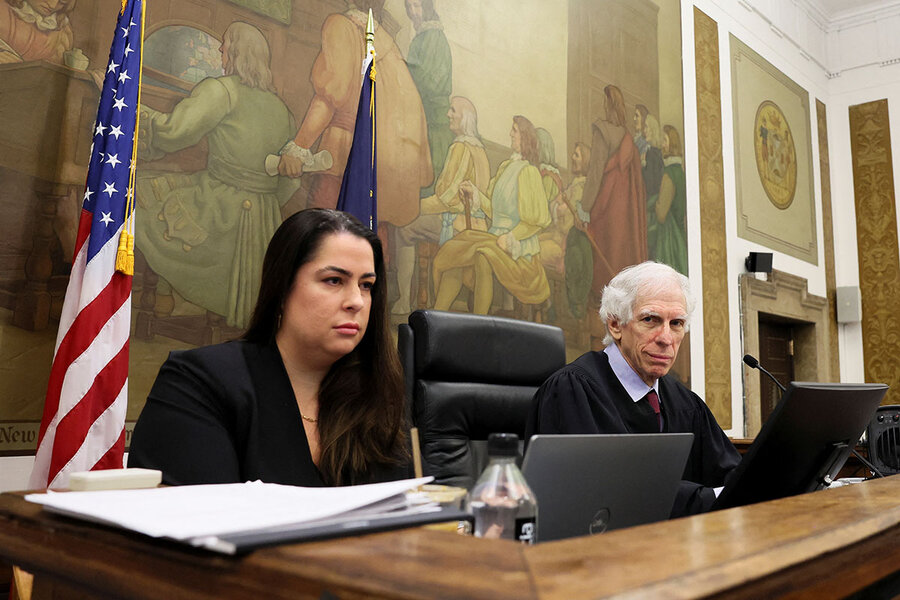
Or perhaps it is because of the penalties the fraud case could entail. It could end up forcing The Trump Organization to divest itself of many of Mr. Trump’s signature New York buildings, in essence disbanding much of his empire.
Days before the trial started, Judge Engoron issued a ruling appointing an independent receiver to “dissolve” Mr. Trump’s business entities in the state. Such a punishment is not unprecedented under New York law, say some legal experts. But it is usually applied to smaller businesses that are defrauding retail customers.
“Here in contrast, the initial order seemed to cover ‘all’ Trump-affiliated and Trump family-affiliated entities, effectively ordering them to be liquidated,” says Eric Talley, a professor at Columbia Law School, in an email. “I expect [in the end] the breadth and scope would get narrowed somewhat.”
Where the case stands
The central charge of the New York civil trial is that Mr. Trump, his sons, and others in The Trump Organization fraudulently inflated the value of some of their real estate holdings to receive better terms from banks and insurance companies.
Judge Engoron has already ruled that the defendants are guilty of this action. Prior to the trial’s beginning he issued a finding that Attorney General James had submitted “conclusive evidence” that the former president and his cohorts had overvalued their assets by between $812 million and $2.2 billion from 2014 to 2021.
The trial will determine the penalties resulting from this finding. Prosecutors have asked the court to fine Trump companies at least $250 million, and to bar Mr. Trump and his family from owning companies or borrowing money in New York ever again.
The prosecution opened the case, presenting evidence that individual Trump properties were worth much less than claimed on Trump company annual financial statements. Mr. Trump’s Trump Tower apartment was valued as if it were 30,000 square feet, as opposed to its actual size of slightly more than 10,000 square feet. Mr. Trump’s Mar-a-Lago property was valued as if it could be turned into a private residence, whereas legal agreements with Palm Beach restrict its use to a club.
Former Trump lawyer Michael Cohen took the stand and testified that his former boss would ask him to increase the value of his total assets “based upon a number he arbitrarily selected.”
In his own appearance, Mr. Trump admitted that he would sometimes look at his financial statements as they were being developed and offer suggestions. But he also distanced himself from their production, saying Trump Organization employees were responsible for final figures.
Mr. Trump’s defense
The foundation of Mr. Trump’s defense has been that real estate valuation is an art, not a science. Different people use different methods to arrive at projected value, and the worth of the Trump “brand” can and should be factored in, Trump lawyers have said. During his upcoming appearance, Mr. Trump is likely to argue that his financial statements, if anything, underestimated his net worth.
Donald Trump Jr. previewed this approach during his own defense appearance two weeks ago, during which he gave a slideshow of Trump properties and extolled them as “great, iconic projects,” while praising his father’s “incredible vision.”
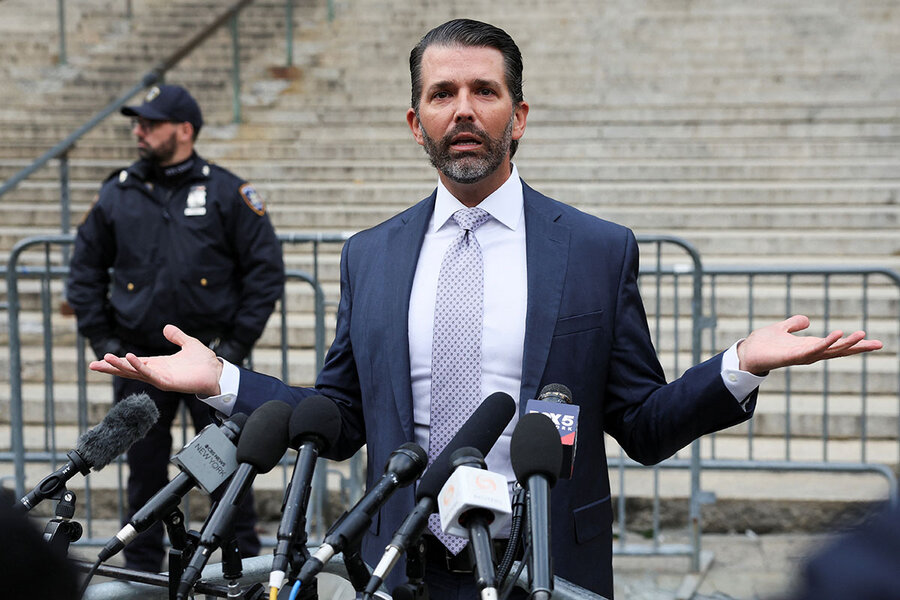
In his initial testimony at the trial, the former president also expounded at length on what he called the “worthless” clause included in his financial statements. This refers to a provision that says banks and other financial institutions should not rely on Trump Organization statements for complete accuracy, and should do their own due diligence.
Banks did not really pay much attention to the statements, Mr. Trump said in his testimony. Nor were they harmed by any inaccuracies, he said, as the banks and insurance firms all made money from dealing with the Trump Organization.
On Tuesday, Mr. Trump’s defense called to the stand Deutsche Bank managing director David Williams, who testified that he was unaware of his firm ever putting a Trump loan into default. Deutsche Bank made its own estimation of how much debt load the Trump Organization could carry, Mr. Williams said.
In his pretrial ruling, however, Judge Engoron rejected the “worthless” clause defense, writing that the New York law under which the Trumps have been charged does not require harm for defendants to be found guilty. It only requires evidence of fraudulent activity.
“The mere fact that the lenders were happy doesn’t mean the statute wasn’t violated,” Judge Engoron said in court on Tuesday.
What happens next?
The fate of Judge Engoron’s gag order could be decided at any time. On Monday, Trump lawyers filed a request that the order be terminated, saying it violated Mr. Trump’s constitutional right to speak, and that he is not responsible for “third parties” who have flooded social media and the judge’s office with death threats and vile language directed at Judge Engoron and his clerk.
In the trial, Mr. Trump’s defense seems set to wrap up shortly after he is scheduled to testify. A verdict would likely be handed down in mid-to-late December.
The former president has faced an uphill climb in the proceedings, given that the judge already found him guilty of the central charge. Yet his defense may accomplish what it set out to do, according to Stephen A. Saltzburg, a law professor and co-director of the Litigation and Dispute Resolution Program at George Washington University Law School.
Mr. Trump’s lawyers have made clear that Trump entities are not conceding anything and are insisting that the finding of fraud in this case was premature. Their presentations seem to have been almost a public relations campaign aimed at paving the way for a lengthy appeals process.
“Whether the defense strategy will have much impact on the judge is doubtful, but it appears that the defense is playing a long game and counting on an appeal to provide some relief,” says Professor Saltzburg in an email.

Americans need child care help. Enter the Child Care Business Lab.
The lack of affordable child care is holding back the United States. It is keeping parents out of the workforce, stunting household financial stability and the economy. But in Maine, a fresh idea: the Child Care Business Lab, which makes it easier for entrepreneurs to offer child care. Early results are promising.

- Quick Read
- Deep Read ( 9 Min. )
-
Alfredo Sosa Staff photographer
Miranda Taylor is bucking local and national trends: She has successfully opened an in-home day care.
Taylor Tots Childcare, which started in 2021, operates out of a wood-paneled room attached to her family’s house in rural Canton, Maine. “There’s no commute. I’m here if my kids need me,” she says.
On a recent afternoon, Ms. Taylor points to a 2-year-old boy playing in the room. He has been with her since he was 3 months old. His mother needed to return to work but couldn’t find child care in the area. Ms. Taylor saw her post on a local site and offered to enroll him as soon as she could open.
It’s the type of story that Child Care Business Lab leaders hoped would emerge, given the significant need of parents. The program, run by a community development financial institution called Coastal Enterprises Inc., launched in 2020. Since then, lab graduates, such as Ms. Taylor, have started 28 new child care businesses, serving more than 500 children in Maine. Another dozen are actively pursuing licenses.
The economic ripple effect from any new child care business is obvious, says Charlie Woodworth, executive director of Greater Franklin Economic and Community Development, in one of Maine’s counties. “You see it immediately.”
Americans need child care help. Enter the Child Care Business Lab.
From the outside, the light peeking through a window of the modest one-story home provides the only clue the day has begun at Kingfield Kinder Care.
Inside, Jackie Lobdell dotes on the children already in her care. She serves bite-size grapes and cinnamon bread to two diaper-clad little ones, checks on an older girl reading a book, and keeps an eye on her lively 3-year-old, Emilia, whose energy defies the time on the clock. It’s 6:45 a.m.
The first parent dropped her daughter off at 5:30 a.m. The early start helps fill a need Ms. Lobdell says she witnessed firsthand after she and her husband started fostering “Em,” whom they plan to adopt. Back then, she worked at the Poland Spring bottling plant in this central Maine town that otherwise relies on the logging, recreation, and tourism industries.
She and her husband cobbled together a patchwork quilt of child care.
“That didn’t work for my work schedule,” she says. “We were missing a lot of time.”
The experience fueled a longstanding desire to open her own child care center. But the question often holding Ms. Lobdell and other aspiring child care providers back can be summed up in one word: How?
The Child Care Business Lab – run by a community development financial institution called Coastal Enterprises Inc. (CEI) – helped her figure that out. Kingfield Kinder Care opened in 2021.
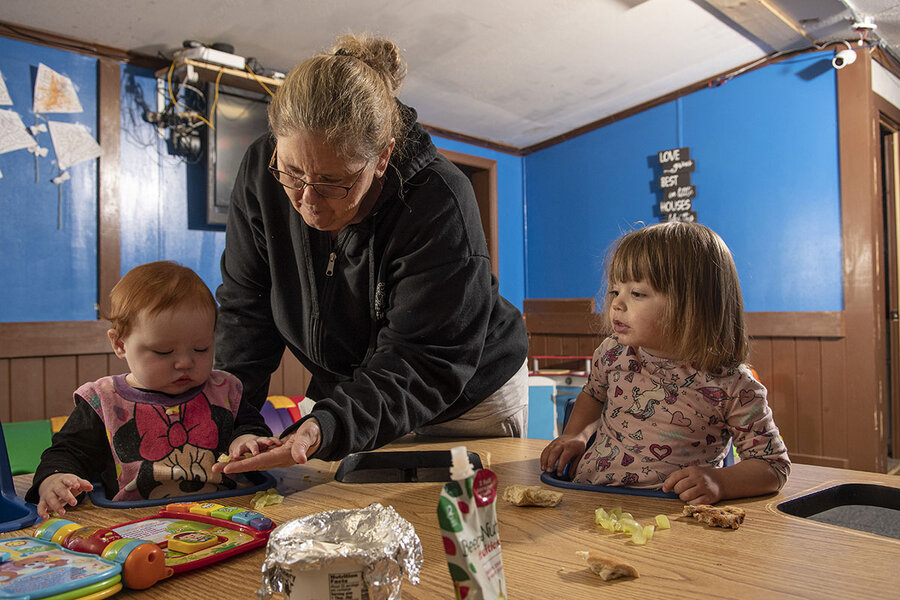
The approach provides a glimpse into one way that states are addressing the problem of high child care demand and too few providers. Experts say the supply-and-demand mismatch limits opportunities for families and communities alike: Without reliable and affordable child care, parents can’t join the workforce, stunting household financial stability and regional economies.
The business lab zeroes in on the access part of the equation, offering a pathway for those yearning to work in child care. But it’s not a one-size-fits-all approach. The businesses that have emerged exist in houses, commercial space, and immigrant communities where cultural relevance gives parents extra peace of mind.
“We want to meet people where they are and make sure that we’re giving them the support so that they can establish a financially viable child care business,” says Cynthia Murphy, the workforce solutions senior program director at CEI.
Sustainability has come under the microscope as pandemic-era funding dries up. When the pandemic put further stress on the feeble child care system in the United States, the federal government offered a life raft via $24 billion worth of stabilization funds, which expired on Sept. 30. Another $15 billion for the existing Child Care and Development Block Grant program faces a 2024 sunset. By some estimates, the loss of the pandemic-era federal funding could leave more than 3 million children without care across the U.S., further stiffening competition for families seeking placements.
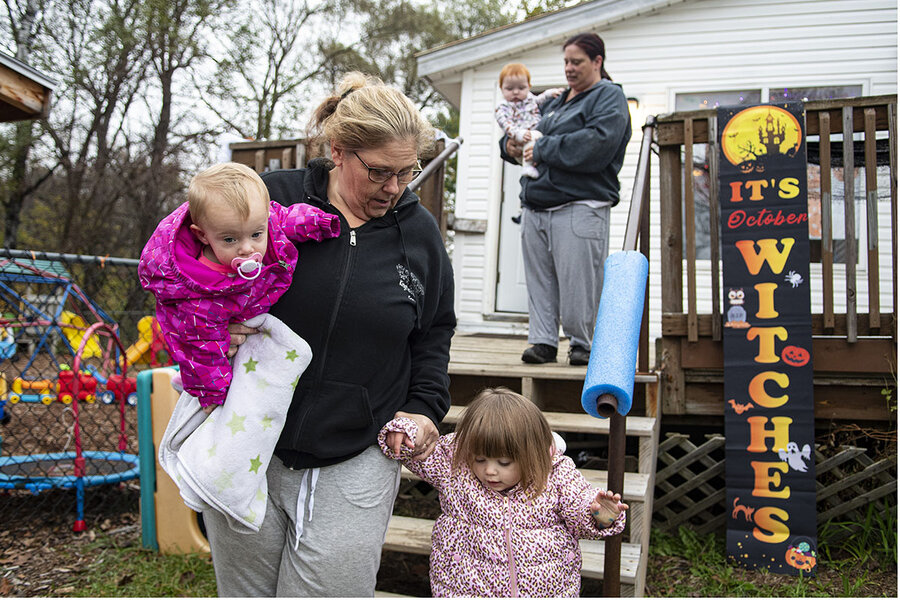
As states and communities seek solutions, advocates say it’s time to start recognizing the problem as a societal, not individual, one.
“When we can figure out how to make it easier to start a child care business – and easier and more sustainable to run a child care business – I think we all win in that situation,” says Anne Hedgepeth, chief of policy and advocacy at the nonprofit Child Care Aware of America.
“We’re here to help you”
On a drizzly Saturday morning in late October, six women fan out across a large room in Brunswick, a coastal town about a half-hour north of Portland. They’re carrying poster boards, glue sticks, markers, magazines, and scissors.
Their mission: create a vision board for their future child care business. What are the sights and sounds? How are kids handling their big emotions? Why are parents choosing this place?
“We’re not here to tell you what your child care should look like,” Alexandra Forrester, the program developer at CEI, instructed minutes earlier. “We’re here to help you understand the regulations and the laws and things that you have to have done.”
It’s the first day of a new cohort for the Child Care Business Lab. Since the lab’s launch in 2020, its graduates have started 28 new child care businesses, serving more than 500 children in Maine. Another dozen are actively pursuing business licenses, Ms. Murphy says.
CEI has been fielding inquiries from outside the state and is hoping to help others replicate the Child Care Business Lab model. “We have funding from Lumina Foundation to create a national learning cohort of other organizations wanting to start similar programs,” Ms. Murphy adds.
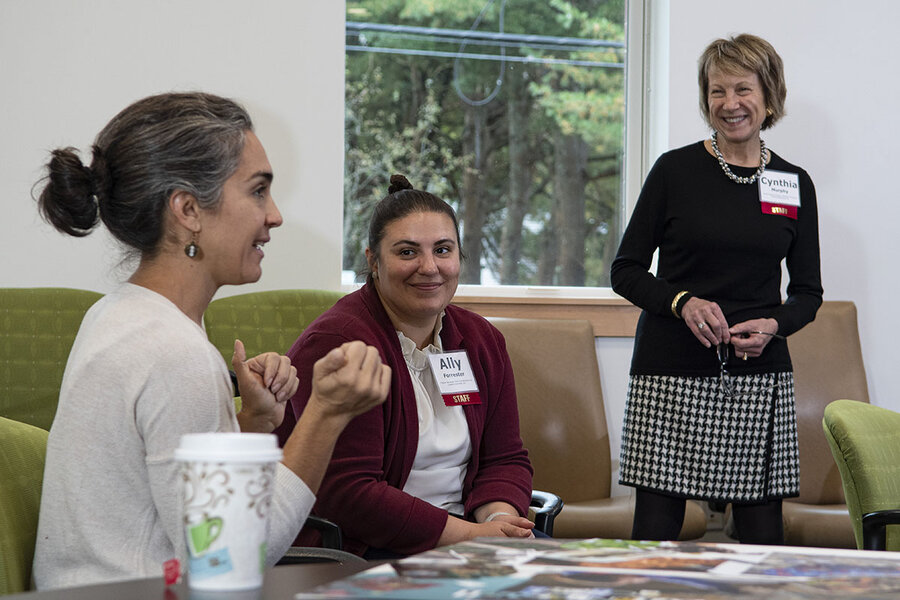
The lab grew out of an observation she made while helping Maine businesses find employees. Lack of child care consistently emerged as an employment barrier, Ms. Murphy says. Some parents reported they had tried securing a placement immediately upon learning of a pregnancy – only to still be looking for child care months after their baby’s birth.
“These stories were heartbreaking,” she says. “It just became very clear that if we could increase access to quality child care, we could get more people into the workforce.”
It’s a particularly pressing issue in Maine, where residents’ median age is 44.8, the highest of any U.S. state. The Pine Tree State also has low workforce participation compared with other states, sitting at a seasonally adjusted rate of 58.8% in October, according to economic data from the Federal Reserve. But if the state hopes to attract younger residents who can join the workforce, economic development officials know a key factor will be its child care infrastructure.
The three-month business lab, powered by a combination of federal and philanthropic funding, is free for applicants accepted into the program. The course walks aspiring child care owners through market research, business planning, securing financing, the licensing process, and, ultimately, managing their business. On the money end, aspiring child care providers receive financial advising and dive into the numbers, including calculating start-up costs and the income they need to earn, which may vary by person.
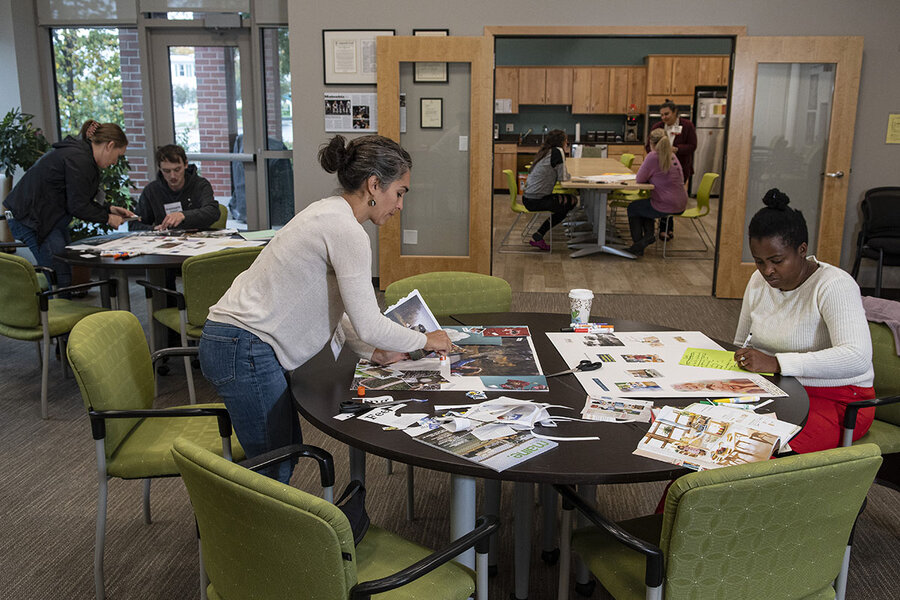
In essence, leaders say, the lab provides a recipe for navigating what could be an intimidating business and regulatory landscape.
“It’s so important for the audience that we’re serving here in child care because these are people who may not have ever even had a loan before,” Ms. Murphy says. “They may have no experience in business.”
For Ms. Lobdell, market research began at her local grocery store. She posted flyers and spoke to shoppers who came and went, confirming her suspicion that more child care was needed, especially in the early morning hours.
After Kingfield Kinder Care opened, Sprite York eventually learned of its existence. On a recent morning, she helps her 2-year-old son, Stiles, remove his Mickey Mouse shoes in the center’s front entryway that was bursting with Halloween decorations. Ms. York previously worked nights, putting a strain on her family life. Child care in the region, she says, is “very far and few between.”
By late November, Ms. Lobdell had 15 children on her wait list, with more inquiries coming weekly. Her husband has been building an addition on the house-turned-child care center to meet the need. It’s a passion project more than a business venture, she says, adding that her income is still below what she earned at the bottling plant.
She started Kingfield Kinder Care to help her community. Providing children a safe and happy place keeps her going, she says, but she wishes society valued her profession on a level akin to teachers.
“We’re not babysitters,” she says. “We’re educational people just like the rest of them.”
Ripple effect from new providers
Licensed child care programs of all kinds are needed in Maine. But home-based programs have plunged the most, down nearly 22% since 2019, according to a 2022 report from Child Care Aware of America. Nationally, the number of family child care homes fell by 11% during that same time frame.
Miranda Taylor is bucking that trend in Canton, Maine. Taylor Tots Childcare, which opened in 2021, operates out of a wood-paneled room attached to her house.
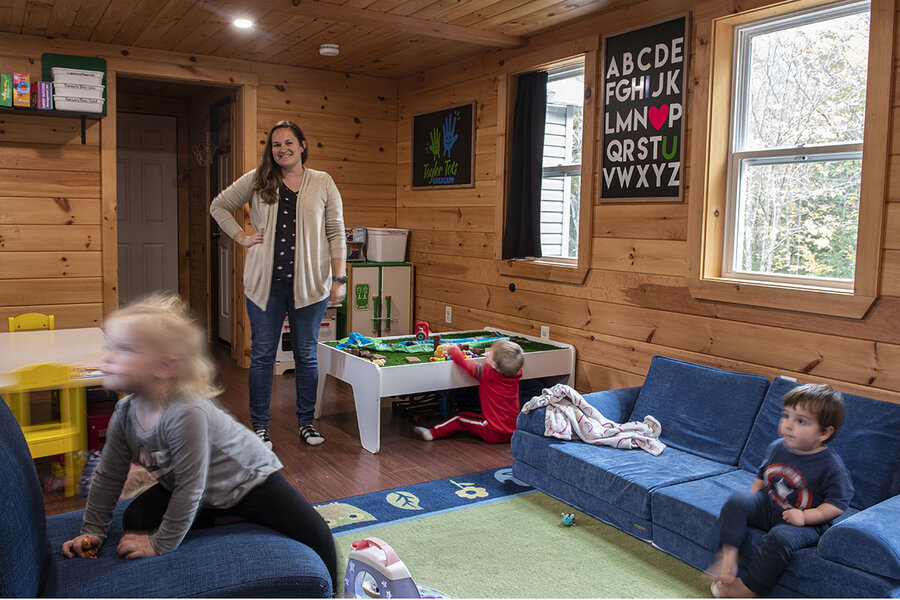
Ms. Taylor originally wanted to find a commercial location for her business, but the tight real estate market kept delaying her dream. After joining the business lab, though, she realized a more financially viable and convenient strategy was to build a room onto her family’s home in rural Maine.
Her child care business – filled with toddlers, toys, and tiny furniture – has a separate entrance but is also just down the hall from her own older children. “There’s no commute. I’m here if my kids need me,” she says.
Ms. Taylor points to a 2-year-old boy playing in the room. He has been here since he was 3 months old. His mother needed to return to work but couldn’t find child care in the area. Ms. Taylor saw her post on a local site and offered to enroll him as soon as she could open.
It’s the type of story that the Child Care Business Lab leaders hoped would emerge. At another child care business that opened this year, 44% of parents say they were able to start a job, Ms. Murphy says.
In neighboring Franklin County, where Kingfield Kinder Care operates, Charlie Woodworth sees child care as the key to creating a vibrant economy. He’s the executive director of Greater Franklin Economic and Community Development.

He notices job postings everywhere, but with an aging and shrinking population, the region needs more young people. The catch: The county has roughly 1,500 children who are 5 years old or younger but only day care spots for about 740.
“Parents are prevented from reentering our workforce,” he says. But the economic ripple effect from any new child care business that opens is obvious. “You see it immediately.”
“The workforce behind the workforce”
President Joe Biden recently asked Congress for an additional year of child care stabilization funding worth $16 billion. Given partisan wrangling, it’s still unclear whether lawmakers will approve that portion of a supplemental funding request.
“There are signs of support, but obviously we’re in a challenging time right now,” says Karen Schulman, director of state child care policy at the National Women’s Law Center.
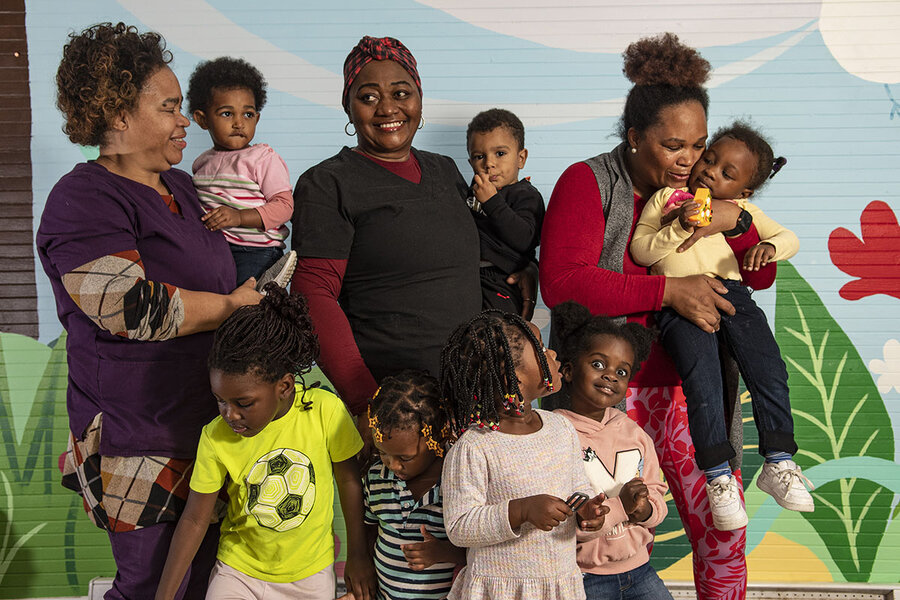
Some states, including Maine, have taken the plunge on their own and funneled more money to child care. This year the Maine Legislature passed a bill, signed by Gov. Janet Mills, that expands eligibility for families who receive child care subsidies – allowing those who make 125% of the state’s median income to qualify, up from 85%.
As states ponder how to strengthen their child care systems, Ms. Hedgepeth of Child Care Aware of America encourages efforts that help providers navigate the regulatory process or reduce administrative burdens. For instance, she says some family child care networks help administratively by pooling resources and offering assistance with business services, alleviating some pressure on individual caregivers.
In Maine, the improved landscape includes the sound of children playing outside at Kingfield Kinder Care, books being read at Taylor Tots Childcare, a movie lulling little ones to sleep during naptime at Kids & Co. Childcare Center in Turner, and the Portuguese language drifting through Happy Little Paradise, which is run by a group of Angolan immigrants in Lewiston. All these child care providers went through the business lab before filling a critical need in their communities.
“Day care is the workforce behind the workforce,” says Ganan Mancini, owner and director of Kids & Co. Childcare Center. “Without us, parents can’t get to their jobs.”
Editor’s note: This article has been updated to clarify information about the child care portion of a supplemental funding request made by President Biden.

How lab-grown diamonds are reshaping this western India city
Advancements can bring huge benefits, but also leave some people behind. In India, growing diamonds in a lab could be an economic boom. But for Surat, a global hub of the diamond trade, the idea imperils wealth and a way of life. Can the industry be profitable for all?
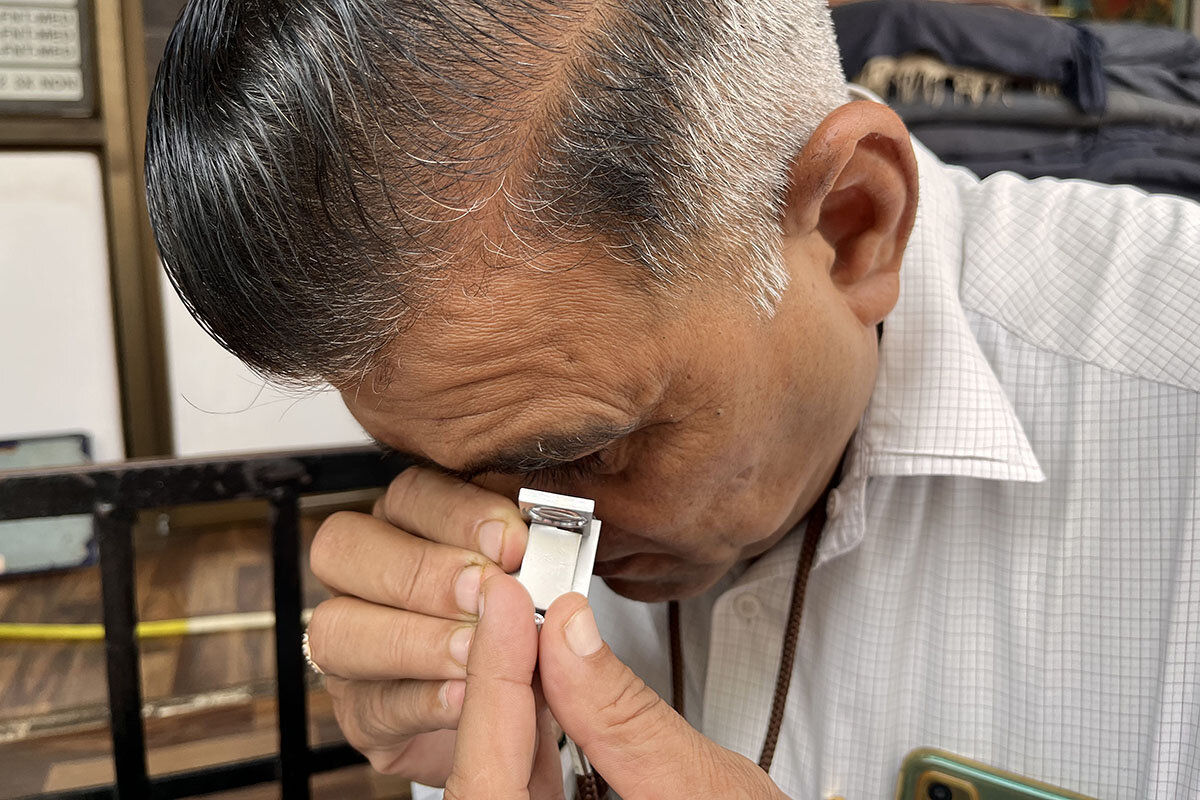
- Quick Read
- Deep Read ( 5 Min. )
An estimated 90% of the world’s diamonds are processed in the western Indian city of Surat, yet few come from Indian mines. Most rough gems are imported from countries such as Russia, and an increasing number are beginning life closer to home: in India’s new wave of state-of-the-art diamond labs.
Considered an ethical and affordable alternative to natural diamonds, lab diamonds are a burgeoning industry and the Indian government wants a slice. Leaders are promoting the shift, framing the influx of lab-grown diamonds, whose market share has more than doubled over the past year, as a way to shake India’s dependency on foreign suppliers.
But while some hail the synthetic gems for democratizing a luxury item, others fear their over-supply is bad news in an already slow market. In Surat, opinion is divided over whether this shift is helping or hurting those in the middle, particularly the city’s diamond polishers.
“We do get some employment because of lab-grown diamonds, but their future isn’t secure,” says Bhavesh Tank, vice president of the diamond workers’ union in Surat, who wants the government to put a cap on the number of lab-grown diamonds entering the market. “What is real is real, demand for natural diamonds will bounce back.”
You can’t say the same about lab-grown diamonds, he adds.
How lab-grown diamonds are reshaping this western India city
In a warren of narrow lanes in western India, almost every man carries a paper pouch in his pocket full of glittering diamonds. Among them is Nagji Rawal.
Back at his shop, the diamond broker sits cross-legged with a velvet jewelry tray perched on his lap. Using his thumb and middle finger, he gingerly picks up a tiny diamond and brings it to eye level, peering at it through an eyepiece that he wears on a long rope around his neck.
An estimated 90% of the world’s diamonds are processed here in Surat, India, yet few come from Indian mines. Most of the diamonds that pass through Mr. Rawal’s shop are imported from mine-rich countries such as Russia or Botswana, but this batch began life closer to home – specifically, in India’s new wave of state-of-the-art diamond labs.
Friendlier to the environment and consumers’ wallets, lab diamonds are a burgeoning industry and the Indian government wants a slice.
Leaders are promoting the shift, framing the influx of lab-grown diamonds, whose market share has more than doubled over the past year, as a way to shake India’s dependency on foreign suppliers. But while some hail the synthetic gems for democratizing a luxury item, others fear their over-supply is bad news in an already slow market. On the streets of Surat, opinion is divided over whether this shift is helping or hurting those in the middle.

“We do get some employment because of lab-grown diamonds, but their future isn’t secure,” says Bhavesh Tank, vice president of the diamond workers’ union in Surat. “What is real is real, demand for natural diamonds will bounce back.”
You can’t say the same about lab-grown, he adds.
The allure of lab diamonds
Lab-grown diamonds are seen as an ethical alternative to natural diamonds, whose mining has been linked to human rights abuses in several countries. They also cost about a third of the price of regular diamonds, despite being virtually identical in look and feel. Even veteran diamantaires can’t tell them apart without specialized equipment.
“Earlier, only the rich could afford to wear a diamond, but now, the poor can also fulfill their dreams,” says Mr. Rawal, who believes that lab diamonds are here to stay. He says most people coming to him these days ask for lab-grown.
Diamond trader Siddharth Parekh, who’s based just a few blocks away, says that five years ago, very few people knew about lab diamonds. In the past year or so, awareness among both customers and traders has increased. “The market has changed,” he says, adding that he can envision India’s lab-grown diamonds being useful not only to jewelers, but also in medical and drilling industries.

As the popularity of lab-grown diamonds soars worldwide, India is eyeing a larger share of the market, which is currently dominated by China. Whereas China produces diamonds mainly using the high-pressure, high-temperature method, India is emerging as a leader in another technique called chemical vapor deposition. In the 2023-2024 budget, India’s government removed the 5% customs duty on seeds, the starting material used to make lab diamonds, and announced a $29 million research grant to a top university to promote domestic diamond manufacturing.
When Prime Minister Narendra Modi visited the White House this summer, he gifted first lady Jill Biden a 7.5-carat diamond grown by the Surat-based firm Greenlab. The company pivoted from natural to lab diamonds four years ago.
From his swanky office in Surat, Greenlab director Smit Patel describes how a few companies control the supply of mined diamonds. Lab diamonds break that monopoly, he says, and are the “pinnacle” of Atmanirbhar Bharat, or self-reliant India, a central motto of the Modi government.
“We can grow our own rough, we can cut and polish in India, we can set jewelry in India, and we can export it around the world,” Mr. Patel says.
But some argue that the enthusiasm for lab diamonds has gone too far.

A demand-supply mismatch
The synthetic gems have, at times, been a boon for laborers. When the Ukraine war broke out and sanctions disrupted the supply of rough diamonds from Russia, Mr. Rawal says lab-grown diamonds kept Surat’s artisans afloat.
Yet increased production of lab diamonds has resulted in abundant supply even as demand in the West remains sluggish, causing all diamond prices to drop. That doesn’t bode well for the diamond industry, particularly its most vulnerable workers: diamond polishers.
“High inventory of polished diamonds amid falling retail prices will put the profitability of polishers under the pump,” said a recent press release by the rating agency CRISIL, noting that polished diamonds have become 10-15% cheaper.
“We see the Indian diamond industry shrinking by over a third on an annualized basis this fiscal,” its director Rahul Guha noted.
For months, laborers have been coming to Mr. Tank, the union leader, with complaints about reduced wages and late payments. He says 32 workers have died by suicide since July. Mahesh Singh, who has been polishing diamonds for the past 30 years, reports that his income has nearly halved.
The main problem, he says, is low demand. In addition to reduced demand from India’s main markets in the West, turmoil in Israel, another big customer, is making Surat’s diamond industry jittery. Workers are also paid per carat, and while there shouldn’t be much difference in wages between natural and synthetic diamonds, Mr. Singh says lab-grown diamonds are sometimes harder, and therefore take longer to finesse. That means polishers get paid less for the same amount of hours at the wheel.

Although lab-grown diamonds brought the city much-needed work when rough diamond supplies were disrupted, Mr. Tank says the government must now step in to regulate. “They should put a limit on the number of lab-grown diamonds coming into the market,” he insists.
But Mr. Patel of Greenlab says India can’t afford to pull the reins while China is also trying to capture the market.
Vipul Shah, chair of India’s Gem and Jewellery Export Promotion Council, notes that reliable data on lab-grown diamonds and their impact on the gem market is hard to find.
“It’s a new segment, and since a lot of new plants have been put up, we are not sure whether it’s oversupply,” he says. But he isn’t worried. He believes the “lab-grown diamond segment is going to be complementing the natural,” rather than competing.
Shantanu Guha Ray, author of “The Diamond Trail: How India Rose to Global Domination,” agrees.
Lab-grown diamonds are “the number two diamond preference for people who genuinely love diamonds,” he says. “The real diamond is a real diamond.”
While synthetic diamonds may never outshine the natural ones, some in Surat feel they are dimming their sparkle. Alpesh Shah, who trades exclusively in natural diamonds, says the overwhelming availability of lab diamonds has contributed to a downturn in his business, with more customers choosing the affordable alternative.
And if everyone has a diamond, Mr. Shah says, it will no longer be considered precious.

A chance to grow: How China and a British town are sowing seeds
How can you tell if animals are coming back to restored ecosystems? Just listen. An acoustic monitoring system in Ecuador is one of our global points of progress this week. We also have a creative attempt to address food insecurity in England, and China showing humility. Its job training program is taking into account other countries’ needs.
A chance to grow: How China and a British town are sowing seeds

1. Canada
Canada’s Supreme Court is majority-female for the first time. Prime Minister Justin Trudeau chose Mary Moreau to replace a retiring justice, giving the court five female and four male members.
Ms. Moreau most recently served as chief justice of Alberta’s superior court and has been a judge for 29 years. As a lawyer she first became known as a defender of French-language rights and has practiced criminal law, constitutional law, and civil litigation. She’s “somebody who is determined to make changes, but within the existing structures,” said Justice Karen Horner, an Alberta colleague.
Previous appointments by Mr. Trudeau have also expanded the diversity of Canada’s top court. In 2021, Mahmud Jamal, who was born in Kenya to parents from India, became the first nonwhite person to sit on the court. And a year later, Michelle O’Bonsawin became the court’s first Indigenous jurist.

Sources: The Globe and Mail, The Guardian, Canadian Broadcasting Corp.
2. Ecuador
Researchers used sound analysis to demonstrate the recovery of tropical forests in biodiverse northeast Ecuador. While reforestation aids in climate change mitigation as the newer trees capture carbon, it can be difficult to determine if animals are also rebounding alongside flora. But using a combination of acoustic monitoring, artificial intelligence tools, and DNA-based surveys, scientists in Ecuador’s Chocó rainforest found that species do return to regenerating forests.
The team examined a variety of land types across 43 plots, from farmland to old-growth forests. Employing recordings of ambient noise, one analysis used a deep-learning model trained on 75 bird sounds, which greatly added to the information that expert human ears alone can detect. Another analysis combined several acoustic indices, which summarize information from soundscapes and are often used as a proxy for biodiversity. The team also analyzed DNA from trapped bugs to estimate the diversity of insects present.
The researchers stress the cost effectiveness of sound data, encouraging the further development of machine learning tools that process animal sounds other than birds’. Passive sound monitoring of conservation areas can even help prevent greenwashing by companies and contribute to evidence-informed conservation funding, they wrote.
Sources: Mongabay, Nature Communications
3. United Kingdom
Hull will become the first city in Britain to give people the “right to grow” food on unused land. In a unanimous vote, Hull’s City Council passed a motion permitting community organizations, charities, and small groups of neighbors to cultivate fruit and vegetables on underutilized public spaces. Advocates say the move will promote healthy local foods and increase food security. The motion comes amid skyrocketing demand for allotments – small parcels of land for gardening that local authorities across the U.K. have been required by law to rent to residents since the early 20th century.
The City Council will create a map of the land it owns and help those wishing to grow their own food overcome practical obstacles, such as meeting insurance requirements and providing water for the plants. Incredible Edible, a network of 150 community growing groups, has advocated for a national “right to grow” law.
“It will benefit Hull in many ways,” said local councilor Gill Kennett of the plan. “We do need cheap food. In terms of mental health benefits, growing food gives people ... confidence, it ticks so many boxes.”
Source: The Guardian
4. China
Chinese technical schools are educating specialized workers in some two dozen locations in Africa and beyond. Since 2016, China’s Luban Workshops have graduated thousands of students in fields ranging from railway operations to robotics and artificial intelligence. Named for a master carpenter from the fourth century B.C., the workshops provide equipment and free training to local residents on how to work with Chinese-owned technology. In September, a new workshop opened at Meru University of Science and Technology in Kenya.

Observers say that as an international program, the workshops mark a change in how China is spreading its influence and a signal that China has listened to its critics. The Belt and Road Initiative, the developing-world infrastructure projects led by China, has been criticized for relying heavily on Chinese labor and materials. The Confucius Institutes, roughly 500 programs that sought to teach Mandarin around the world, have been scrutinized for the academic environment created by largely Chinese-educated faculty. But the Luban Workshops have avoided such criticism by working closely with local authorities and tailoring curricula to the needs of the location.
Sources: The Economist, The Washington Post
5. Mozambique
Lions are returning to parts of Africa, thanks to “landscape mosaics” and public-private cooperation enabling better conservation. The lion population has plummeted to around 20,000, and its historical habitat has shrunk by more than 90%. But work across borders among conservationists, park staff, and landowners to connect patches of land has created ecological corridors and given the big cats the vast stretches they need to roam and reclaim places where they have not been seen in years.
Zinave National Park in Mozambique, which forms the eastern slice of the Great Limpopo Transfrontier Conservation Area in southern Africa, was devastated after 15 years of civil war. But in 2021, after several years of reintroducing animals to the park, a camera trap spotted a lion. Since lions had not yet been reintroduced, it must have migrated hundreds of miles across the conservation area. Nature preserves have also found success in Chad, where not all the corridors are formally protected, but male lions are using them as they search for territory.

Other parks, such as Kafue National Park in Zambia, use similar approaches. Conservationists emphasize that their work includes supporting communities in these areas to reduce conflict between humans and wildlife.
Source: Mongabay

Other headline stories we’re watching
(Get live updates throughout the day.)The Monitor's View
Rising seas, rising compassion
- Quick Read
- Deep Read ( 2 Min. )
-
By the Monitor's Editorial Board
Every time the world gathers to measure its progress in addressing climate change, doubts and hopes collide. The annual United Nations climate conference that started today in Dubai is no different.
One point these meetings affirm, however, is that smaller gestures and local agency matter as much as global agreements in breaking the world’s dependency on fossil fuels and adapting to a warming planet. A novel agreement between Australia and the island nation of Tuvalu in the South Pacific holds useful lessons.
The two countries brokered the world’s first bilateral agreement on climate mobility earlier this month. With a highest elevation of just 15 feet, Tuvalu faces the risk of being swallowed by sea-level rise. The deal seeks to ensure “human mobility with dignity.” Australia has extended an open invitation to Tuvalu’s 11,000 residents to study, live, and work in Australia permanently.
Critics note the offer gives Australia a veto over future diplomatic relationships Tuvalu may pursue with other countries, reflecting Canberra’s strategic concerns about China’s regional influence. But it shows that climate agreements between nations – particularly between richer and poorer nations – do not always hinge on financial obligations. They can be forged on common values like compassion and defense of individual dignity.
Rising seas, rising compassion

Every time the world gathers to measure its progress in addressing climate change, doubts and hopes collide. The annual United Nations climate conference that started today in Dubai is no different. It will showcase new advances in technology but underscore missed targets.
One point these meetings repeatedly affirm, however, is that smaller gestures and local agency matter as much as global agreements in breaking the world’s dependency on fossil fuels and adapting to a warming planet. A novel agreement between Australia and the island nation of Tuvalu in the South Pacific holds useful lessons.
The two countries brokered the world’s first bilateral agreement on climate mobility earlier this month. With a highest elevation of just 15 feet, the nine-island nation of Tuvalu faces the risk of being swallowed by sea-level rise. Under the deal, designed to ensure “human mobility with dignity,” Australia has extended an open invitation to Tuvalu’s 11,000 residents to study, live, and work in Australia permanently.
Critics of the offer note that it gives Australia a veto over future diplomatic relationships Tuvalu may pursue with other countries, reflecting Canberra’s strategic concerns about China’s regional influence. But it shows that climate agreements between nations – particularly between richer and poorer nations – do not always hinge on financial obligations. They can be forged on common values like compassion and justice.
“Dignified, rights-based responses to climate mobility are crucial,” notes Jane McAdam, director of the Kaldor Centre for International Refugee Law at the University of New South Wales. The deal emphasizes the importance of preserving individual agency. An open assurance of safe haven, she said, also means Tuvaluans can “stay in their homes with safety and dignity” for as long as they desire.
The deal also reflects a growing view that adapting to climate change fits into the existing international framework of rights – and that nations are therefore bound together by obligations of mutual care. “A human rights approach ... has the potential to address injustices and inequities that exist between states,” the authors wrote in the journal Climate Action last week. That involves protecting “the adaptive capacity of individuals” amid climate disruptions.
The government officials, scientists, and activists seeking new resolve and cooperation in Dubai can draw on the world’s expanding pursuit of solutions to climate change through local measures. In their response to the potential threat of climate dislocation, Australia and Tuvalu offer one model of adaptation rooted in a defense of individual dignity.

A Christian Science Perspective
Each weekday, the Monitor includes one clearly labeled religious article offering spiritual insight on contemporary issues, including the news. The publication – in its various forms – is produced for anyone who cares about the progress of the human endeavor around the world and seeks news reported with compassion, intelligence, and an essentially constructive lens. For many, that caring has religious roots. For many, it does not. The Monitor has always embraced both audiences. The Monitor is owned by a church – The First Church of Christ, Scientist, in Boston – whose founder was concerned with both the state of the world and the quality of available news.
Water walking
- Quick Read
- Read or Listen ( 3 Min. )
-
By Mark Swinney
When troubles arise, we can rely on Christ for inspiration that not only keeps us afloat, but heals.
Water walking
One night, Jesus’ disciples had been rowing in a boat for hours against the wind. Then, in the darkness, Jesus came toward them, “walking upon the sea” (Mark 6:48).
This was startling to those in the boat, who at first thought he was a ghost. When they cried out in distress, Jesus allayed their fears and joined them on the boat, at which point the weather became calm and peaceful.
Even in the midst of the violent winds, the jostling waves, and his disciples’ fears, Jesus didn’t sink; he simply came to the disciples and comforted them.
In light of world events today, perhaps there’s a timely lesson here. When things get rough, there’s an alternative to getting caught up in fear. We can follow Jesus’ lifelong example by letting prayerful inspiration guide how we see things – turning to God for new, spiritual views of truth and reality.
Mary Baker Eddy, who founded Christian Science, says of Jesus, “Walking the wave, he proved the fallacy of the theory that matter is substance; healing through Mind, he removed any supposition that matter is intelligent, or can recognize or express pain and pleasure. His triumph over the grave was an everlasting victory for Life; it demonstrated the lifelessness of matter, and the power and permanence of Spirit” (“Miscellaneous Writings 1883-1896,” p. 74).
God is infinite Mind and Life. And because He is also infinite Spirit, true substance is not material, but spiritual. Even when circumstances seem otherwise, the presence and power of God, good, are fully in place. God loves and cares for all of us, His flawless spiritual creation, actively and ceaselessly.
We always have opportunities to honor God by holding to a steady love for everything that God is and does. The Christ – God’s inspiring and healing message of God’s supreme power – is here for us today, too. In a poem called “Christ My Refuge,” Mrs. Eddy includes this comforting verse:
And o’er earth’s troubled, angry sea
I see Christ walk,
And come to me, and tenderly,
Divinely talk.
(“Poems,” p. 12)
When we’re receptive to Christ, Truth – which comes to all of us – healing and peace are natural results.
I experienced this when I was healed of a long-standing foot deformation that made walking difficult and painful. So often, I would be distracted by my trouble. Yet through consistent prayer, there was a shift in my thinking. I became more steadily attentive to God, Spirit, than to the problem.
I began to realize that God never sees us as material or flawed at all, and that the way God sees us is the truth of what we are. This statement of Mrs. Eddy’s supported my prayers: “The lens of Science magnifies the divine power to human sight; and we then see the supremacy of Spirit and the nothingness of matter” (Miscellaneous Writings, p. 194).
Humbly, I learned to prayerfully walk forward – to more consistently strive to perceive reality through God’s perspective. I couldn’t help but love the permanent beauty and goodness of God and of myself – and everyone – as God’s spiritual offspring.
As I stayed with these truths, yielding to God’s Christly, healing messages to me, I was healed permanently. The foot took on a normal shape, and in the decades since I’ve enjoyed a number of active pursuits.
When tempted to be distracted by storms – whether in our own lives, or in the world around us – we can do our own form of “water walking,” so to speak. With God’s help, we can hold to the supremacy of Spirit, God, who is always here to love and inspire every one of us. In this way, we can stay buoyant and mentally on course to progress and healing. As Jesus proved, this is a powerful, effective approach to prayer, illustrating the Bible’s promise, “Thou wilt keep him in perfect peace, whose mind is stayed on thee” (Isaiah 26:3).

Viewfinder
Helping hands
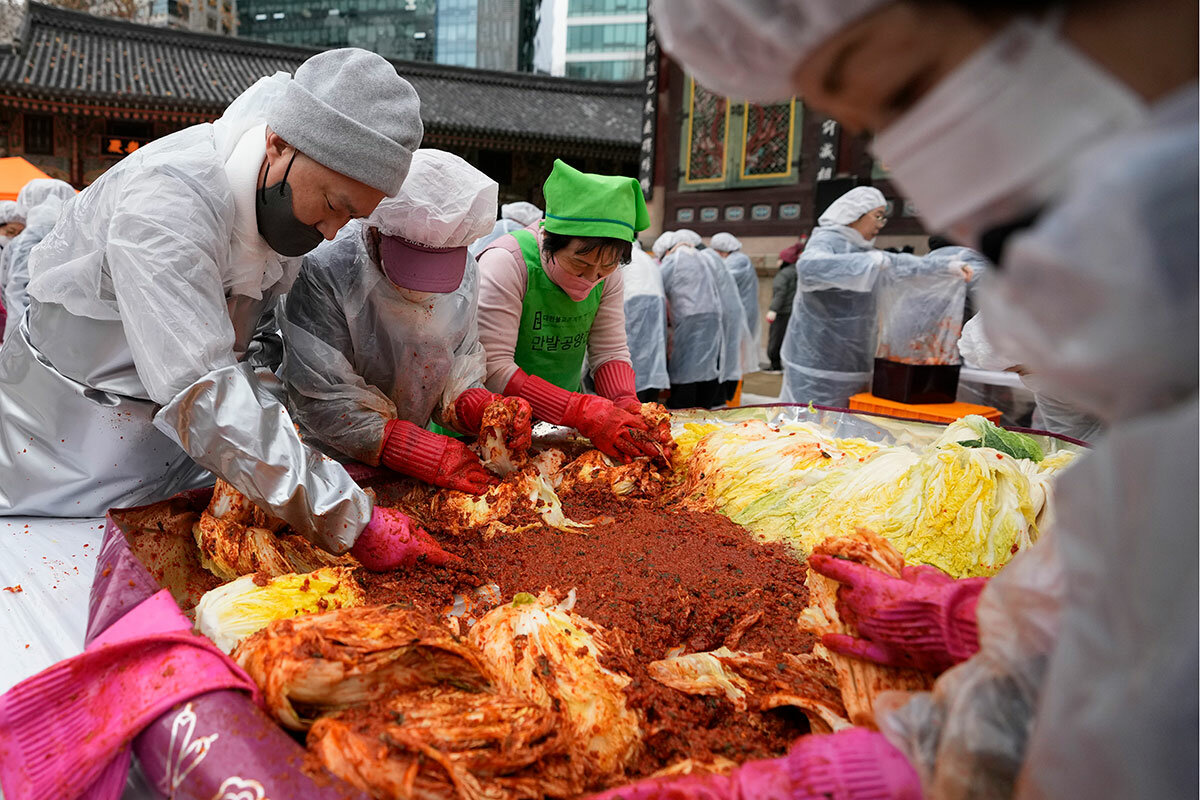
A look ahead
Thank you for joining us today. Tomorrow, we’ll head into the political ring for a 12-round prize fight: Whose approach to governing the United States is better, blue or red? Media personality Sean Hannity invited Florida’s Republican governor, Ron DeSantis, and California’s Democratic governor, Gavin Newsom, to have a debate. Our contribution: a set of graphics that gets below the talking points to explore key factual comparisons. Make sure to bring some popcorn.



